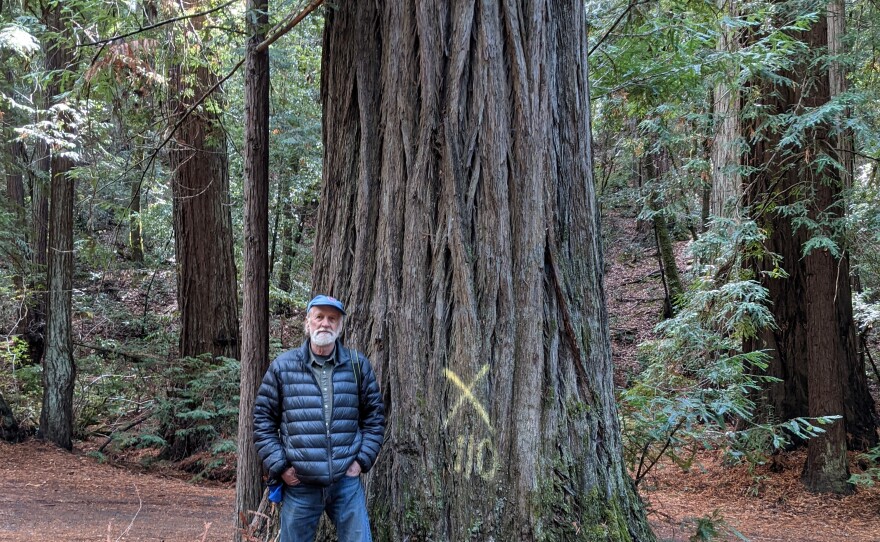October 26, 2021 — Faulkner Park is a little-known gem of Mendocino County, known for wild azaleas and a history of providing refreshment to bears. The forty-acre park, formerly known as Bear Wallow, is just a few miles up Mountain View Road outside Boonville. Now, neighbors are rallying to protect dozens of its giant redwoods from a PG&E plan to remove them, citing the safety of its infrastructure.

Steve Wood has owned property adjacent to the park for 45 years and has always walked his dogs there. Last week, he led an impromptu tour along the Azalea Trail and pointed out some of the trees that were marked for removal. Pausing beside a pair of huge, fire-scarred redwoods that had grown together, he estimated the larger at about six feet in diameter. “It’s marked with a number and an X, which indicates they’re planning to cut it,” he noted. “As far as we know.” This pair of ancient conjoined twins is about 250 feet away from the power lines.
Nine-year-old Laila loves the azaleas, and noted that Faulkner park celebrated its 91st birthday this month. She noted that the azaleas depend on the redwood canopy, and added, “I am here today because the redwoods should not be cut down.” She said she has been enjoying the park for about six years.

About twenty neighbors, including five kids and a few dogs, gathered in the park on a drizzly morning
to talk about how to protect it, from contacting state representatives to taking direct action. That’s what thirteen-year-old Zane Colfax says he’s prepared to do. “I don’t want to see these trees cut, especially when PG&E has other options,” he said.
Mike Mannix, whose family has owned land nearby since the 1930’s, thinks it would be easier on the company’s bottom line to leave the park alone. “It’s a square forty acres,” he specified. “So we’re only talking about a quarter of a mile of road. It wasn’t that long ago that the fiber optic cable went from inland Mendocino County all the way out to the coast from here. I mean, we’re talking a chunk of change to take trees out, compared to how much it costs to underground a quarter of a mile of county road.” Asked if he has PG&E at his home or business, he said, “No, I don’t do business with PG&E. I find them unreliable and overpriced.”
PG&E has received authorization to pass along much of the cost of its wildfire mitigation efforts, including vegetation management, to its ratepayers, plus 15-20%, depending on which account it lands in. Resident Donna Pierson Pugh thinks this may have something to do with the company’s approach. “I do think that perhaps they’re making a choice in doing the clear cutting and limbing, which is perhaps more attractive to them because of the ability or the option they have of passing that on to consumers, as opposed to burying of lines or putting the insulated lines in instead of the current lines,” she noted.
A few days after the meeting in the park, Supervisor Ted Williams spoke about a meeting between county staff and company representatives, to ask PG&E to hold off on cutting until after some discussion with county government. “It looked like about 91 trees marked,” he reported. “These are good-sized trees. It would have a significant impact on the park, which is owned by the people, and I think PG&E can find another way to mitigate the fire risk without cutting hundreds of feet in either direction.” He is confident that “we’re going to be able to find a compromise.” He supports undergrounding the lines, but added, “The county likely doesn’t have the authority to force PG&E to underground, and I know they will cite significant expense. That said, in this case, we’re only talking about a fifth of a mile and I think they can find a workable solution that doesn’t involve taking out a redwood forest.” He said he thinks the role of the supervisors is to “steer the discussion,” but that “likely, we will need to involve our state reps.” Asked if he supports direct action like tree sitting and blockading the roads, he said, “I hope it doesn’t come to that...I hope we can have a rational discussion, sitting down to discuss options. Ultimately, it may come to that, and I support the people taking a stand. These are their trees. This is their park.”
For David Severin, the potential crisis of the park is an opportunity for the neighbors to get together to do something about climate change and the future.
He walked through the park before the community meeting, and said he saw a lot of work that he could do himself to “dress up the park and make it a lot friendlier,” like sprucing up plaques and walkways. “I have twelve grandchildren,” he added, “and I feel a really strong obligation toward those grandchildren and to the future that I’m handing off to them. And this park is important for that. For them.”






